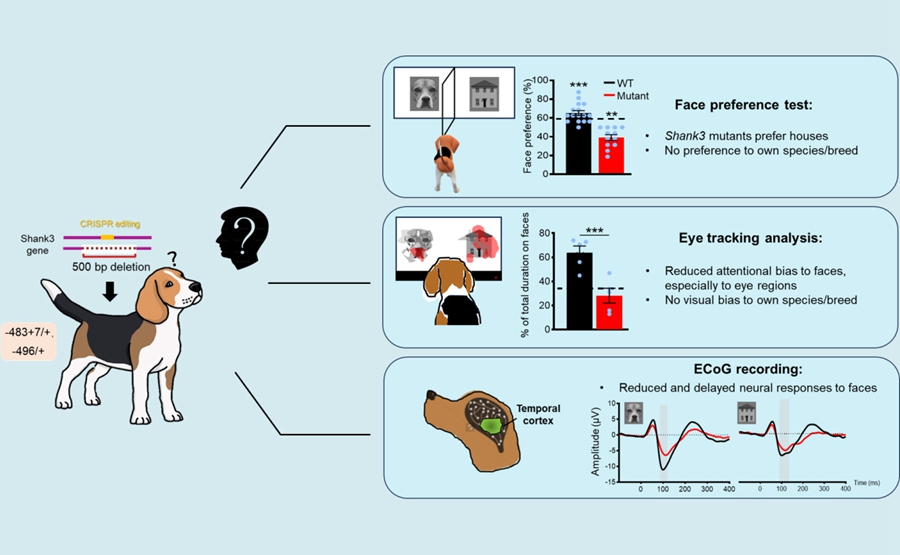
A new study has revealed that Beagle dogs carrying mutations in the Shank3 gene—a high-risk gene for autism spectrum disorder (ASD)—exhibit face processing abnormalities similar to those observed in human ASD patients.
The research, published on April 3 in Science Advances, was led by Prof. ZHANG Yongqing from the Institute of Genetics and Developmental Biology of the Chinese Academy of Sciences and Prof. HAN Shihui from Peking University.
ASD is a complex group of neurodevelopmental conditions characterized by social impairments and repetitive behaviors. Human social interactions heavily rely on the ability to accurately process facial information, and abnormalities in this cognitive function are considered a key contributor to the social deficits seen in ASD patients. Although numerous ASD-associated risk genes have been identified, it remains unclear whether specific genetic mutations can directly cause impairments in face processing.
To investigate this question, the research team developed a face-based social preference test to assess face recognition behavior in Shank3 mutant dogs compared to their wild-type counterparts. The results showed that mutant dogs exhibited a reduced preference for facial stimuli and lacked the typical inclination toward conspecific faces—faces of the same species—indicating deficits in face-related social behavior.
To further examine visual attention to faces, the researchers employed eye-tracking technology. They confirmed that Shank3 mutant dogs showed significantly reduced attention to faces, with a notable decrease in gaze directed at the eye region of human faces.
The team also used electrocorticography (ECoG) to record brain activity, revealing that Shank3 mutant dogs exhibited both a diminished amplitude and delayed response in the face-specific N1 brainwave component, which typically occurs around 100 milliseconds after presentation of facial stimuli.
In another experiment, the researchers explored the dogs' ability to categorize different types of faces—such as by species and breed—using the repetition suppression paradigm, a widely accepted method in human studies. Wild-type dogs were able to distinguish between facial categories, showing an earlier response to faces of other species and a later response to conspecific faces. In contrast, Shank3 mutant dogs displayed deficits in face categorization.
This study provides direct experimental evidence that mutations in Shank3 lead to ASD-like deficits in face processing, which may contribute to social impairments. Additionally, it establishes a novel experimental model for future research into the genetic and neural mechanisms underlying ASD.

Autism-associated Shank3 mutant Beagle dogs show altered face preference and face processing deficits recapitulating that in autistic people. (Image by IGDB)
ZHANG Yongqing
Institute of Genetics and Developmental Biology
E-mail: yqzhang@genetics.ac.cn

86-10-68597521 (day)
86-10-68597289 (night)

52 Sanlihe Rd., Xicheng District,
Beijing, China (100864)

